On this Day in History ... 7th May
07 May is in May.
1527 Visit of the French Ambassadors
1533 Marriage of Henry VIII and Anne Boleyn
1603 Knighting at Theobalds House
1697 Invitation to William of Orange from the Immortal Seven
Events on the 7th May
On 07 May 973 Otto I King Germany I King Italy Holy Roman Emperor (age 60) died. His son Otto "Red" II King Germany II Holy Roman Emperor II King Italy (age 18) succeeded II King Germany.
On 07 May 1196 King Philip II of France (age 30) and Agnes Andechs Queen Consort France were married. She by marriage Queen Consort of France. She the daughter of Berthold Andechs Duke Merania and Agnes Rochlitz. He the son of Louis VII King Franks and Adèle Blois. He a great x 2 grandson of King William "Conqueror" I of England. 

Calendars. 07 May 1461. Middleham Castle [Map]. Grant to the king's (age 19) kinsman Richard, Earl of Warwick (age 32), of the custody of all lordships, manors and lands with knight's fees and advowsons held by the king's uncle George Neville (age 54), knight, lord Latymer, within the county of York or elsewhere, during the idiotcy of the latter, even though no inquisition has been taken. By other letters patent.

Calendars. May 7. [1527] Sanuto Diaries, v. xlv. pp. 194–198.
105. Gasparo Spinelli, Venetian Secretary in London, to his brother Lodovico Spinelli, in Venice.
On the 4th instant all the ambassadors, with the exception of the Emperor's, were summoned to Greenwich, where, in the presence of the King and the chief personages of the Court, the French ambassador, the Bishop of Tarbes, delivered an oration, which was answered by the Bishop of London, who, on the morrow, Cardinal Wolsey being unable to officiate from indisposition, sang mass with the usual ceremonies; after which at the high altar, where the missal was opened by the Cardinal, the French ambassadors swore in his hands (“in mano dil R~mo Cardinal”) to observe the perpetual peace now concluded with the King of England, he on his part swearing in like manner.
Two of the ambassadors, namely the prelate and the soldier, dined with the King, the others dining together apart.
On rising from table they went to the Queen's apartment, where the Princess (age 11) danced with the French ambassador, the Viscount of Turenne, who considered her very handsome (“molto bella”), and admirable by reason of her great and uncommon mental endowments; but so thin, spare, and small (“cosi magreta et scarma et picola”) as to render it impossible for her to be married for the next three years.
Then yesterday1 there was a joust, the challengers at the tilt (“al campo”) being four2, the competitors (“concorrenti”) sixteen, each of whom ran six courses; a very delectable sight, by reason of the prowess of the knights. The joust ended with the day, not without rain, which rather impeded the jousting.
The King and the Queens3, with some 200 damsels (“damigelle”), then went to the apartments which I informed you in a former letter were being prepared [on one side of the list-yard at Greenwich] for the reception of the French ambassadors, the rest of the company following them. The site adjoined the other chambers from whence the King and the nobility view the jousts. They were but two halls, about thirty paces in length, and of proportional height and breadth. The centre of the ceiling of the first hall was entirely covered with brocatel of no great value, but producing a good effect; the walls were hung with the most costly tapestry in England, representing the history of David; and there was a row of torches closely set, illuminating the place very brilliantly, being ranged below the windows, which were at no great distance from the roof. The royal table was prepared in front of the hall, with a large canopy of tissue (“soprarizo”), beneath which was the King, with the Queens, his wife and sister, at the sides. Then came two long tables, at one of which, on the right-hand side, were seated the French ambassadors and the Princes, each pairing with some great lady. At the other table, to the left, the Venetian ambassador and the one from Milan placed themselves, with the rest of the lords and ladies. At no great distance from the two tables were two cupboards, reaching from the floor to the roof, forming a semicircle, on which was a large and varied assortment of vases, all of massive gold, the value of which it would be difficult to estimate, nor were any of them touched; silver gilt dishes of another sort being used for the viands of meat and fish, which were in such variety and abundance that the banquet lasted a long while.
The door of this hall was in the form of a very lofty triumphal arch, fashioned after the antique, beneath which were three vaulted entrances; through one passed the dishes for the table, through the other they were removed, and on each side of the centre one, which was the largest, stood two enormous cupboards bearing the wine to be served at table. Over the triumphal arch was a spacious balcony for the musicians, bearing the arms of the King and Queen, with sundry busts of Emperors, and the King's motto, “Dieu et mon droit” and other Greek (sic) words. Could never conceive anything so costly and well designed (“ben ordinata”) as what was witnessed on that night at Greenwich.
On rising from table all were marshalled, according to their rank, along a corridor of no great length to the other hall, which was of rather less size than the first. The floor was covered with cloth of silk embroidered with gold lilies. The ceiling, which was well nigh flat, was all painted, representing a map of the world (“mapamondo in Alpa forma”), the names of the principal provinces being legible; there were also the signs of the zodiac and their properties (“le loro proprietà”), these paintings being supported by giants. Along the sides of the hall were three tiers of seats, each of which had a beam placed lengthwise, for the spectators to lean on, nor did one tier interfere with the other. Above these tiers were in like manner three rows of torches, so well disposed and contrived as not to impede the view.
Within the space for the spectators, on the right-hand side, in the first tier, the ambassadors were placed, in the second the Princes, in the third those to whom admission was granted, they being few. On the opposite side, in the same order, were the ladies, whose various styles of beauty and apparel, enhanced by the brilliancy of the lights, caused me to think I was contemplating the choirs of angels; they, in like manner, being placed one above the other. Two-thirds of the distance down the hall, an arch of a single span had been erected, its depth being five feet and a half [English measure], all gilt with fine gold, the inside of the arch being decorated with a number of beautiful figures in low relief. The magnificence of this arch was such that it was difficult to comprehend how so grand a structure could have been raised in so short a space of time. In the centre, to the front (“nel fronte nel mezo”), stood the royal throne (“soglio”), on which the King sat, the two Queens being seated below at his feet.
All the spectators being thus methodically placed, without the least noise or confusion, and precisely as pre-arranged, the entertainment commenced. One thing above all others surprised me most, never having witnessed the like any where, it being impossible to represent or credit with how much order, regularity, and silence such public entertainments proceed and are conducted in England. First of all, there entered the hall eight singers, forming two wings, and singing certain English songs; in their centre was a very handsome youth alone, clad in skyblue tatfety, a number of eyes being scattered over his gown; and having presented themselves before the King, the singers then withdrew in the same order, there remaining by himself the youth, who, in the guise of Mercury, sent to the King by Jupiter, delivered a learned Latin oration in praise of his Majesty; which panegyric being ended, he announced that Jupiter, having frequently listened to disputes between Love and Riches concerning their relative authority, and that being unable to decide the controversy, he appointed his Majesty as judge, and requested him to pronounce and pass sentence on both of them. Thereupon Mercury departed, and next came eight young choristers of the chapel, four on each side; those to the right were all clad in cloth of gold, much ornamented, and the first of them was Cupid (“Amor”); the others to the left were variously arrayed, and their chief was Plutus (“la Richesa”); in the centre walked one alone, in the guise of Justice, who sang.
In this order they presented themselves to the King, before whom Justice commenced narrating the dispute between the parties, in English, and desired Cupid (“Amor”) to begin with his defence, to which Plutus (“la Richeza”) replied, each of the choristers on either side defending their leaders, by reciting a number of verses. The altercation being ended, Cupid and Plutus determined that judgment should go by battle, and thus, having departed, three men-at-arms in white armour, with three naked swords in their hands, entered from the end of the hall, and having drawn up under the triumphal arch, an opening was made in its centre by some unseen means, and out of the arch fell down a bar, in front of which there appeared three well-armed knights. The combat then commenced valiantly, man to man, some of them dealing such blows that their swords broke. After they had fought some while, a second bar was let down, which separated them, the first three having vanquished the others, fighting with great courage; and the duel (“duello”) being thus ended, the combatants quitted the hall in like manner as they had entered it. Thereupon there fell to the ground at the extremity of the hall a painted canvas [curtain], from an aperture in which was seen a most verdant cave (“antro”) approachable by four steps, each side being guarded by four of the chief gentlemen of the Court, clad in tissue doublets and tall plumes, each of whom carried a torch. Well grouped within the cave were eight damsels of such rare beauty as to be supposed goddesses rather than human beings. They were arrayed in cloth of gold, their hair gathered into a net, with a very richly jewelled garland, surmounted by a velvet cap, the hanging sleeves of their surcoats (“camisa”) being so long that they well nigh touched the ground, and so well and richly wrought as to be no slight ornament to their beauty. They descended gracefully from their seats to the sound of trumpets, the first of them being the Princess, hand in hand with the Marchioness of Exeter (age 24). Her beauty in this array produced such effect on everybody that all the other marvellous sights previously witnessed were forgotten, and they gave themselves up solely to contemplation of so fair an angel. On her person were so many precious stones that their splendour and radiance dazzled the sight, in such wise as to make one believe that she was decked with all the gems of the eighth sphere. Dancing thus they presented themselves to the King, their dance being very delightful by reason of its variety, as they formed certain groups and figures most pleasing to the sight. Their dance being finished, they ranged themselves on one side, and in like order the eight youths, leaving their torches, came down from the cave, and after performing their dance, each of them took by the hand one of those beautiful nymphs, and having led a courant together (“menata una chorea”) for a while, returned to their places.
Six masks then entered. To detail their costume would be but to repeat the words “cloth of gold,” cloth of silver,” &c. They chose such ladies as they pleased for their partners, and commenced various dances, which being ended, the King appeared. The French ambassador, the Marquis of Turrene, was at his side, and behind him four couple of noblemen (“signori”), all masked, and all wearing black velvet slippers on their feet, this being done, lest the King should be distinguished from the others, as from the hurt which he received lately on his left foot when playing at tennis (“allo palla”) he wears a black velvet slipper. They were all clad in tissue doublets, over which was a very long and ample gown of black satin, with hoods of the same material, and on their heads caps of tawney velvet. They then took by the hand an equal number of ladies, dancing with great glee, and at the end of the dance unmasked; whereupon the Princess with her companions again descended, and came to the King, who in the presence of the French ambassadors took off her cap, and the net being displaced, a profusion of silver tresses as beautiful as ever seen on human head fell over her shoulders, forming a most agreeable sight. The aforesaid ambassadors then took leave of her; and all departing from that beautiful place returned to the supper hall, where the tables were spread with every sort of confection and choice wines for all who chose to cheer themselves with them. The sun, I believe, greatly hastened his course, having perhaps had a hint from Mercury of so rare a sight; so showing himself already on the horizon, warning being thus given of his presence, everybody thought it time to quit the royal chambers, returning to their own with such sleepy eyes that the daylight could not keep them open.
As the Bishop of Tarbes is departing tomorrow morning in haste, I will not be more diffuse. He will be accompanied by Master Poyntz [Sir Francis Poyntz] and Clarencieux, king-of-arms, to do what I wrote in a former letter. On their departure each of the ambassadors received a gold cup from his Majesty.
London, 7th May 1527. Registered by Sanuto, 3rd June.
[Italian.]
Note 1. 6th May, according to the date of Spinelli's letter. In Hall's Chronicle (pp. 721, 722, ed. London, 1809), mention is made of the mass at Greenwich on Sunday, 5 May, and of the jousts, but of these last he does not state the precise date, giving, however, the names of the challengers, and adding that whilst they tilted “yt rained apace.”
Note 2. Namely. Sir Nicholas Carew (age 31), Sir Robert Jernyngham, Sir Anthony Browne (age 27), and Nicholas Harvy. (See Hall, as above.)
Note 3. Catharine (age 41), and Mary Queen Dowager of France (age 31).
Letters and Papers 1533. 07 May 1533. Add. MS. 28,585, f. 244. B. M. 454. Count Of Cifuentes to Charles V.
Was told by the Pope that he had letters from his Nuncio [in England] of April 12, saying, that the King had married "la Anna (age 32)" publicly, with all the usual ceremonies. A few days previously he had convoked the Estates for this purpose, and many opposed the King in both Houses (?) (asi de unos como de otros); and this was in the first Parliament. At the second the same thing happened, and the King rose to his feet, bidding those of his party help him, as he wished to marry. The opposition of the other party was at last overcome by money, promises, and threats. To give a colour to what the King wished to do, it was determined that all cases of tithes, marriages, or wills should be decided in the kingdom before ordinary judges, of whom the chief was the principal Archdeacon (archidiano mayor) of London1. The judge of the first and second appeal was the archbishop of Canterbury, with certain prelates. The King summoned the Archbishop, and told him that he should marry (casasse) this Anna. The dukes of Norfolk and Suffolk were sent to intimate this to the Queen.
Note 1. William Clyff, LL.D.
After 07 May 1544 Edward Clinton 1st Earl Lincoln (age 32) was knighted by Edward Seymour 1st Duke of Somerset (age 44) at Edinburgh [Map].
On 07 May 1567 Mary Kitson Countess Rivers was born to Thomas Kitson (age 26) and Elizabeth Cornwallis (age 26).
On 07 May 1592 Christopher Wray (age 68) died. He was buried in St Michael's Church, Glentworth [Map]. Monument to Sir Chistopher and his wife Anne Girlington. Elizabethan Period. Elephant and Castle Crest. Pink, white and blue-grey marble. Two recumbent effigies, Sir Christopher above and a little behind his wife, he in red robes, black cap and thick ruff; she in black robes, large ruff and hood. Four kneeling white marble daughters below. Ornate tomb recess above with flanking pink marble columns with white and gold Corinthian Capitals. Undersurface of Recess decorated with white and gold bay leaves. Plaque inscribed above with raised plaque above with Sir Christopher's son at prayer flanked by coats of arms and obelisks.
Anne Girlington: she was born to Nicholas Girlington. Christopher Wray and she were married. After 07 May 1592 Anne Girlington was buried at St Michael's Church, Glentworth. Before 18 Oct 1602 John Darcy 2nd Baron Darcy Aston and Anne Babington were married. She by marriage Baroness Darcy of Aston.
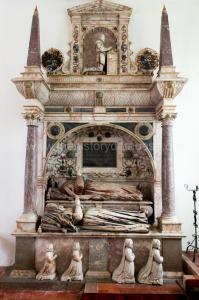
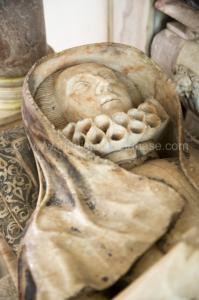
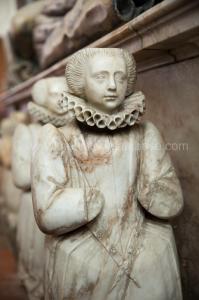
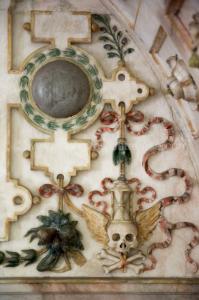
On 07 May 1603 during his journey south King James I of England and Ireland and VI of Scotland (age 36) stayed at Theobalds House, Hertfordshire as a guest of William Cecil 1st Baron Burghley.
King James I of England and Ireland and VI of Scotland (age 36) knighted:
Gervase Helwys (age 41)
John Leventhorpe 1st Baronet (age 43)
Michael Stanhope (age 54).
Thomas Bisshopp 1st Baronet (age 50).
On 07 May 1625 King James I of England and Ireland and VI of Scotland was buried at Westminster Abbey [Map].
Evelyn's Diary. 07 May 1676. I spoke to the Duke of York (age 42) about my Lord Berkeley's (age 74) going to Nimeguen. Thence, to the Queen's Council at Somerset House [Map], about Mrs. Godolphin's (age 23) lease of Spalding [Map], in Lincolnshire.

Evelyn's Diary. 07 May 1685. I was in Westm Hall [Map] when Oates (age 35), who had made such a stir in the Kingdom, on his revealing a Plot of the Papists, and alarm'd several Parliaments, and had occasioned the execution of divers Priests, Noblemen*, &c. was tried for perjurie at the King's Bench [Map]; but being very tedious, I did not endeavour to see the issue, considering that it would be published. Aboundance of Roman Catholics were in the Hall in expectation of the most gratefull conviction and ruine of a person who* had ben so obnoxious to them, and, as I verily believe, had don much mischeife and greate injury to several by his violent and ill-grounded proceedings; whilst he was at first so unreasonably blowne up and encouraged, that his insolence was no longer sufferable. Mr. Roger L'Estrange (age 68) (a gentleman whom I had long known, and a person of excellent parts abating some affectations) appearing first against the Dissenters in several Tracts, had now for some yeares turn'd his style against those whom (by way of hateful distinction) they call'd Whiggs and Trimmers, under the title of Observator, which came out 3 or 4 days every weeke, in which sheets, under pretence to serve the Church of England, he gave suspicion of gratifying another party, by several passages which rather kept up animosities than appeas'd them, especialy now that nobody gave the least occasion.
On 07 May 1697 Edward Russell 1st Earl Orford (age 44) was created 1st Earl Orford by King William III of England, Scotland and Ireland (age 46) in recognition of his support of the Glorious Revolution he having been one of the signatories of the Invitation to William of Orange from the Immortal Seven.
Minutes of the Society of Antiquaries. 07 May 1718. Bought by the Society the Portrait of Edwrd the Third for a Guinea which Mr Treasurer (age 35) is ordered to pay.
Mr Bostue had the Drawing of Richard II delivered to him by Mr Director (age 40) in order for engraving, for which he is to be paid Twenty Guineas. Mr Director [?] gives the use of the Drawing to the Society.
In order to defray the expenses, it is found necessary to raise a voluntary Subscription of Seven Shillings and Six Pence aa [?] of as many [?], for which they [?] the equivalent in prints of the same when finished.
Mr Vertue (age 34) gives the Copper Plate, he is to be paid five Guineas down, five guineas when half finished, and the rest uponm delivery.
In the margin: Pictures of Henry VII and Eliza: his wife
Bought by the Society of Dr Stukeley (age 30), Secretary, an old picture of Elizabeth wife of Harry VII for £12 0s 6d which Mr Tresurer is order to pay.
Bought by the Society an old picture of Henry VII for £1 0s 4d which Mr Treasurer (age 35) is ordered to pay to Mr Norroy (age 57).
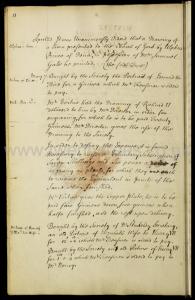
On 07 May 1718 Mary of Modena Queen Consort England Scotland and Ireland (age 59) died.
On 07 May 1768 Aglae de Polignac "Guichette" Duchess Gramont was born to Jules 1st Duke of Polignac (age 21) and Yolande Martine Gabrielle Polastron Duchess Gramont (age 18).
After 07 May 1779. St Mary's Church, Buckden [Map]. Monument to John Green, S.T.P. ie Sacrae Theologiae Doctor ie Doctor of Sacred Theology.
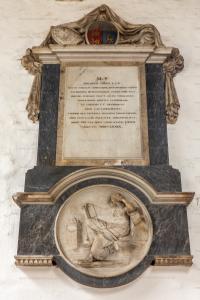
On 07 May 1823 Abraham Solomon was born to Michael Meyer Solomon.
On 07 May 1828 Euphemia "Effie" Gray Lady Millais was born to George Gray and Sophia Margaret Jameson (age 20) at Bowerswell.
The Illustrated London News 1853 May 07. 07 May 1853. It is time now that we speak of Millais (age 23) - Millais the Pre-Raffaelite; the "pretender" Millais that was; the "usurper" Millais that is; the "legitimate" Millais that perhaps (much virtue in that little word) may be; and who has certainly a larger crowd of admirers in his little corner in the Middle Room than all the Academicians put together command; ay, and a crowd intent on what they are about—a good sticking crowd, who, having once taken up their position opposite the object of their homage. are not inclined very soon to move on. but stand there gaping, and staring. and commenting upon the wondrous effects, without any regard to the pressure from behiml of crowds pre. paring to occupy their place. Truth to say. Mr. Millais. in this "Order of Release", has achieved for himself an "order of merit" worth more than any academic hononr. and has earned a fame which a whole corporate academy might be proud to portion amongst its constituent members. Whilst we admit— nay, assert this—we would by no means wish to be understood as enrolling ourselves incontinently of this young artist's "party " (for there is partisanship in everything, even in art); but simply as asserting that Pre-Raffaelitism (or rather the artists who have been foolishly styled Pre-Raffaelites) is a "great fact." and perhaps may lead to the regeneration of art in this country; and we may add that those who did us the honour to read our remarks upon this very subject last year. will perceite that what we now state is perfectly consistent with, indeed confirms, what we then. with somewhat more of reserve and hesitation. put forth. But more of this anon. when we come to engrave the Order of Release," which we hope to do next week. In the meantime. we will only add that the subject is simply that of a wife, with child in her arms. coming with an order of release for her husband, who has been taken in the Civil Wars. The husband, overcome with emotions, and weak from a recent wound (his arm is in a sling). can but fall upon her neck and weep: the woman, "firm of purpose," sheds no tear; she nas none to shed; but her eye is red and heavy witli weeping and waking; and she looks at the stern and unconcerned gaoler with a proud look. expressing that she has won the reward for all her trouble past. The colouring. the textural execution, are marvellous (for these degenerate days); but of these we have not room to say more at present. Mr. Millais has another picture, "A Proscribed Royalist, 1651," concealed in the trunk of an old tree, whom a young lady stealthily visits to supply him with bread; but, though itself a capital specimen of executive skill, it by no means carries the poetic interest of the other work, nor in colouring is it so harmonious.
On 07 May 1886 Frank Meyer 2nd Baronet was born to Carl Ferdinand Meyer 1st Baronet (age 34) and Adele Levis Lady Meyer (age 31).
On 07 May 1913 Mary Spencer Watson was born to George Spencer Watson (age 44) and Hilda Mary Gardiner.
On 07 May 1925 William Lever 1st Viscount Leverhulme (age 73) died. He was buried at Christ Church, Port Sunlight [Map]. His son William Lever 2nd Viscount Leverhulme (age 37) succeeded 2nd Viscount Leverhulme of the Western Isles, 2nd Baron Leverhulme of Bolton le Moors in Lancashire, 2nd Baronet Lever of Thornton Manor in Cheshire. Marion Beatrice Smith Viscountess Leverhulme (age 38) by marriage Viscountess Leverhulme of the Western Isles.
Marion Beatrice Smith Viscountess Leverhulme: On 06 Jul 1886 she was born to Bryce Smith. On 13 Apr 1912 William Lever 2nd Viscount Leverhulme and she were married. In 1936 William Lever 2nd Viscount Leverhulme and Marion Beatrice Smith Viscountess Leverhulme were divorced. On 30 Aug 1987 she died.
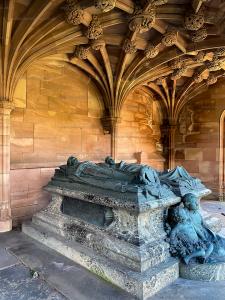
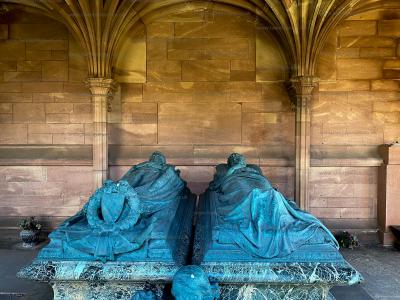
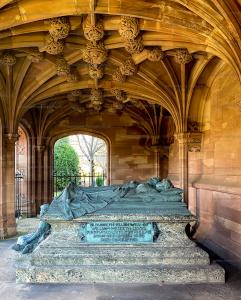
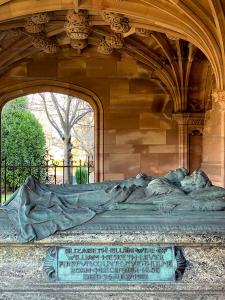
Births on the 7th May
On 07 May 1328 Louis "The Roman" Wittelsbach VI Duke Upper Bavaria was born to Louis Wittelsbach IV Holy Roman Emperor (age 46) and Margaret Hainault Holy Roman Empress (age 16).
On 07 May 1530 Louis Bourbon Prince Condé was born to Charles Bourbon Duke Vendôme (age 40) and Françoise Valois Countess Vendôme (age 40).
On 07 May 1553 Albert Frederick Hohenzollern Duke Prussia was born to Albert "The Elder" Hohenzollern I Duke Prussia (age 62) and Anna Maria Guelph Duchess Prussia (age 21).
On 07 May 1567 Mary Kitson Countess Rivers was born to Thomas Kitson (age 26) and Elizabeth Cornwallis (age 26).
Before 07 May 1570 Catherine Neville was born to Henry Neville (age 50) and Frances aka Elizabeth Gresham (age 28).

On 07 May 1586 Francesco IV Gonzaga Duke of Mantua was born to Vincenzo Gonzaga III Duke Mantua (age 23) and Eleanor de Medici Duchess Mantua (age 19). Coefficient of inbreeding 6.51%.
On 07 May 1587 Richard Newport 1st Baron Newport was born to Francis Newport (age 32) and Beatrice Lacon.
Before 07 May 1622 Andrew Henley 1st Baronet was born to Robert Henley (age 31).
On 07 May 1622 James Boevey was born to Andreas Boevey (age 66) at Mincing Lane St Dunstan's in the East Parish.
On 07 May 1634 Richard Legh was born to Reverend Thomas Legh (age 40).
On or before 07 May 1650, the date she was baptised at St Benet's Church, Paul's Wharf [Map], Susan Herbert Baroness Poulett was born to Philip Herbert 5th Earl Pembroke 2nd Earl Montgomery (age 29) and Catherine Villiers Countess Pembroke and Montgomery (age 29).

On 07 May 1675 Charles Egerton was born to John Egerton 3rd Earl Bridgewater (age 28) and Jane Paulet Countess Bridgewater (age 19).
On 07 May 1695 Robert Grosvenor 6th Baronet was born to Thomas Grosvenor 3rd Baronet (age 38).
On 07 May 1699 John Cullum 5th Baronet was born to Jasper Cullum 4th Baronet (age 24).
On 07 May 1722 Anthony Askew was born.
On 07 May 1733 Henry Roper 11th Baron Teynham was born to Henry Roper 10th Baron Teynham (age 25).
On 07 May 1735 Richard Gorges-Meredyth 1st Baronet was born.
On 07 May 1750 Reverend Charles Belasyse 7th Viscount Fauconberg was born to Anthony Belasyse and Susannah Clarvet.
On 07 May 1768 Aglae de Polignac "Guichette" Duchess Gramont was born to Jules 1st Duke of Polignac (age 21) and Yolande Martine Gabrielle Polastron Duchess Gramont (age 18).
On 07 May 1770 Robert Percy Smith was born.
On 07 May 1773 Evelyn Stuart was born to John Stuart 1st Marquis of the Isle of Bute (age 28) and Charlotte Jane Windsor Marchioness Bute (age 27).
On 07 May 1784 Philip Yorke was born to Philip Yorke 3rd Earl of Hardwicke (age 26) and Elizabeth Lindsay Countess Hardwicke (age 20).
On 07 May 1790 Lionel Charles Dawson was born to John Dawson 1st Earl Portarlington (age 45) and Caroline Stuart Countess Portarlington (age 27).
On 07 May 1794 Ernst Christian Carl Hohenlohe Langenburg I Prince was born.
On 07 May 1795 William Fox-Strangways 4th Earl of Ilchester was born to Henry Thomas Fox-Strangways 2nd Earl of Ilchester (age 47) and Maria Digby Countess Ilchester.

On 07 May 1802 Henry Fox 4th Baron Holland was born to Henry Vassal-Fox 3rd Baron Holland (age 28).
On 07 May 1810 John Gurney Hoare was born to Samuel Hoare (age 27) and Louisa Gurney (age 25).
On 07 May 1813 Mark Egerton was born to Wilbraham Egerton (age 31) and Elizabeth Sykes (age 35). Coefficient of inbreeding 3.12%.
On 07 May 1813 Richard Lumley 9th Earl Scarborough was born to Frederick Lumley-Savile (age 25) and Charlotte Mary Beresford (age 18).

On or before 07 May 1818 Caroline Fountaine was born to Andrew Fountaine (age 47) and Hannah Penrice. She was baptised 07 May 1818 at the Church of St Mary, Narford [Map].
On 07 May 1821 Henry Charles Lambton Cavendish was born to Henry Frederick Compton Cavendish (age 31) and Frances Susan Lambton.
On 07 May 1823 Abraham Solomon was born to Michael Meyer Solomon.
On 07 May 1826 Emily Jane Wodehouse was born to Venerable Charles Nourse Wodehouse (age 35) and Dulcibella Hay (age 32).
On 07 May 1828 Henry Blackwood 3rd Baronet was born to Henry Blackwood 2nd Baronet (age 26).
On 07 May 1828 Euphemia "Effie" Gray Lady Millais was born to George Gray and Sophia Margaret Jameson (age 20) at Bowerswell.
On 07 May 1836 Edward Baldwin Courtenay 12th Earl Devon was born to William Courtenay 11th Earl Devon (age 29) and Elizabeth Fortescue Countess Devon (age 34).

On 07 May 1838 William Strutt was born to Edward Strutt 1st Baron Belper (age 36) and Amelia Harriet Otter Baroness Belper (age 21).
On 07 May 1847 Archibald Philip Primrose 5th Earl Rosebery 1st Earl Midlothian was born to Archibald John Primrose (age 37) and Catherine Lucy Wilhelmina Stanhope Duchess of Cleveland (age 27).

On 07 May 1867 Arthur Clowes was born to Samuel Clowes (age 46) and Adelaide Cavendish (age 26).
On 07 May 1869 Geoffrey Cornewall 6th Baronet was born to George Henry Cornewall 5th Baronet (age 35) and Louisa Frances Bayley Lady Cornewall.
On 07 May 1877 Unnamed Oldenburg was born to Prince Frederick Christian Oldenburg (age 46) and Helena Windsor (age 30). He a grandson of Queen Victoria of the United Kingdom.
On 07 May 1886 Frank Meyer 2nd Baronet was born to Carl Ferdinand Meyer 1st Baronet (age 34) and Adele Levis Lady Meyer (age 31).
On 07 May 1886 Captain Rupert Egerton Lubbock was born to Henry James Lubbock (age 48).
On 07 May 1902 FitzGerald Villiers-Stuart was born to Gerald Villiers-Stuart (age 33).
On 07 May 1904 Mervyn Horatio Herbert 17th Baron Darcy of Knayth was born to George Herbert 4th Earl Powis (age 41) and Violet Ida Evelyn Lane-Fox Countess Powis (age 39).
On 07 May 1907 Irene Williams was born to Stanley Fred Williams of Bromley (age 26) and Marie Louise de Pfeffel (age 25).
On 07 May 1913 Mary Spencer Watson was born to George Spencer Watson (age 44) and Hilda Mary Gardiner.
On 07 May 1937 Anthony Brand 6th Viscount Hampden was born to David Brand 5th Viscount Hampden (age 34) and Imogen Alice Rice Viscountess Hampden (age 33).
On 07 May 1939 Jennifer Nelson 11th Baroness Arlington was born to General John Nelson (age 26) and Margaret Jane Fitzroy (age 23).

Marriages on the 7th May
On 07 May 1196 King Philip II of France (age 30) and Agnes Andechs Queen Consort France were married. She by marriage Queen Consort of France. She the daughter of Berthold Andechs Duke Merania and Agnes Rochlitz. He the son of Louis VII King Franks and Adèle Blois. He a great x 2 grandson of King William "Conqueror" I of England. 

Before 07 May 1243 Hugh D'Aubigny 5th Earl Lincoln 5th Earl of Arundel and Isabel Plantagenet Countess Lincoln and Arundel (age 15) were married. She the daughter of William Warenne 5th Earl of Surrey and Maud Marshal Countess Norfolk and Surrey (age 49). He the son of William D'Aubigny 3rd Earl Lincoln 3rd Earl of Arundel and Mabel Gernon Countess Lincoln and Arundel. He a great x 3 grandson of King Henry I "Beauclerc" England. 


Before 07 May 1567 Thomas Kitson (age 26) and Elizabeth Cornwallis (age 26) were married. He the son of Thomas Kitson and Margaret Donnington Countess Bath.
On 07 May 1567 James "Lord Bothwell" Hepburn 1st Duke Orkney (age 33) and Jean Gordon Countess Bothwell and Sutherland (age 21) were divorced.
Before 07 May 1600 Thomas Hinson (age 49) and Anne Spring (age 47) were married.
On 07 May 1617 John Darcy 3rd Baron Darcy Aston (age 45) and Isabel Wray Baroness Darcy were married. She by marriage Baroness Darcy of Aston.
On 07 May 1640 Richard Wingfield and Elizabeth Folliot (age 20) were married. She the daughter of Henry Folliott 1st Baron Folliott and Anne Strode Countess Roscommon.

On 07 May 1657 John Mordaunt 1st Viscount Mordaunt (age 30) and Elizabeth Carey Viscountess Mordaunt (age 25) were married. He the son of John Mordaunt 1st Earl Peterborough and Elizabeth Howard Countess Peterborough (age 54). They were second cousin once removed.


On 07 May 1659 Thomas Wriothesley 4th Earl of Southampton 2nd Earl Chichester (age 52) and Frances Seymour Countess Southampton (age 41) were married. She by marriage Countess of Southampton. She the daughter of William Seymour 2nd Duke of Somerset (age 71) and Frances Devereux Duchess of Somerset (age 59). He the son of Henry Wriothesley 3rd Earl of Southampton and Elizabeth Vernon Countess Southampton. She a great x 4 granddaughter of King Henry VII of England and Ireland. 



On 07 May 1661 Charles Boyle 3rd Baron Clifford (age 21) and Jane Seymour Baroness Clifford (age 24) were married. She the daughter of William Seymour 2nd Duke of Somerset and Frances Devereux Duchess of Somerset (age 61). He the son of Richard Boyle 2nd Earl Cork 1st Earl Burlington (age 48) and Elizabeth Clifford Countess Burlington (age 47). She a great x 4 granddaughter of King Henry VII of England and Ireland. 



On 07 May 1663 John Russell 3rd Baronet (age 23) and Frances Cromwell Baroness Russell (age 25) were married. She the daughter of Oliver Cromwell and Elizabeth Bourchier (age 65).


On 07 May 1675 John Wolstenholme 3rd Baronet (age 25) and Mary Raynton were married. They had eight children.
Before 07 May 1713 Francis Fortescue 4th Baronet (age 51) and Mary Huddleston Lady Fortescue were married.
On 07 May 1729 Alan Brodrick 2nd Viscount Midleton (age 27) and Mary Capell were married. She by marriage Viscountess Midleton of Midleton in Cork. She the daughter of Algernon Capell 2nd Earl Essex and Mary Bentinck Countess Essex.
On 07 May 1744 Augustus Berkeley 4th Earl Berkeley (age 29) and Elizabeth Drax Countess Berkeley and Nugent (age 24) were married. She by marriage Countess Berkeley. He the son of James Berkeley 3rd Earl Berkeley and Louisa Lennox Countess Berkeley. He a great grandson of King Charles II of England Scotland and Ireland. 

On 07 May 1751 John Waldegrave 3rd Earl Waldegrave (age 33) and Elizabeth Leveson-Gower Countess Waldegrave (age 27) were married. She the daughter of John Leveson-Gower 1st Earl Gower (age 56) and Evelyn Pierrepont Baroness Gower. He the son of James Waldegrave 1st Earl Waldegrave and Mary Webb Countess Waldegrave. He a great grandson of King James II of England Scotland and Ireland. 

On 07 May 1762 William Courtenay 8th Earl Devon (age 19) and Frances Clack Countess Devon were married. He the son of William Courtenay 7th Earl Devon (age 53) and Frances Finch Countess Devon.

On 07 May 1773 Andrew Foley (age 26) and Elizabeth Tomlinson (age 30) were married. They had two sons and four daughters. They were half first cousins.
On 07 May 1790 General William Loftus (age 38) and Elizabeth Townshend were married. She the daughter of George Townshend 1st Marquess Townshend (age 66) and Charlotte Compton 16th Baroness Ferrers Chartley 7th Baroness Compton.


On 07 May 1805 Lieutenant-Colonel William Grey (age 28) and Maria Shirreff (age 23) were married. He the son of Charles Grey 1st Earl Grey (age 75) and Elizabeth Grey Countess Grey (age 61).
On 07 May 1831 Rowland Eyles Egerton-Warburton (age 26) and Mary Brooke (age 21) were married.

On 07 May 1845 Frederick Anson and Caroline Maria Venables-Vernon (age 19) were married. They were second cousin once removed.
On 07 May 1919 Lieutenant-Colonel Thomas Ward (age 56) and Kathleen Lowry-Corry (age 31) were married. The difference in their ages was 24 years. She the daughter of Somerset Lowry-Corry 4th Earl Belmore and Anne Elizabeth Honoria Gladstone (age 77).
Deaths on the 7th May
On 07 May 721 Bishop John of Beverley died.
On 07 May 762 Bishop Frithwald died.
On 07 May 973 Otto I King Germany I King Italy Holy Roman Emperor (age 60) died. His son Otto "Red" II King Germany II Holy Roman Emperor II King Italy (age 18) succeeded II King Germany.
On 07 May 1166 William "Wicked" I King Sicily (age 35) died. His son William "Good" II King Sicily (age 11) succeeded II King Sicily.
On 07 May 1202 Hamelin Warenne 4th Earl of Surrey (age 73) died. His son William Warenne 5th Earl of Surrey succeeded 5th Earl Surrey and inherited his estates including Conisbrough Castle [Map]. He undertook further building work including the Great Hall and service buildings in the Inner Bailey. Maud Marshal Countess Norfolk and Surrey (age 8) by marriage Countess Surrey.

On 07 May 1231 Beatrice Hohenstaufen Duchess Merania (age 38) died.
On 07 May 1243 Hugh D'Aubigny 5th Earl Lincoln 5th Earl of Arundel died at Canelli. He was buried at Wymondham Abbey, Norfolk [Map]. Earl Lincoln extinct. His nephew John Fitzalan 6th Earl of Arundel (age 20) succeeded 6th Earl Arundel Sussex. Cicely D'Aubigny (age 35) and her husband Roger de Montalt inherited Castle Rising Castle [Map].

Before 07 May 1310 Thomas Corbet (age 23) died.
On 07 May 1322 John Marmion (age 56) died in Wethrington.
On 07 May 1402 Amadeus Savoy Prince of Achea (age 39) died.
On 07 May 1427 Thomas la Warr 5th Baron de la Warr (age 75) died. His nephew Reginald West 6th Baron De La Warr 3rd Baron West (age 31) succeeded 6th Baron De La Warr.
On 07 May 1498 Anne Echingham Baroness Audley Heighley (age 78) died.
On 07 May 1501 Anne Devereux (age 11) died.
On 07 May 1522 Ralph Egerton of Wrineshill (age 66) died.
On 07 May 1540 Prior William Weston (age 70) died upon hearing the news of the Order of Knights of the Hospital of Saint John of Jerusalem in England had been dissolved. Hall's Chronicle says 05 May 1540.
On 07 May 1540 Margery Wentworth (age 87) died.
Before 07 May 1558 Anne Barley died.
On 07 May 1567 William Acton (age 70) died.
On 07 May 1568 Francis Cockayne (age 47) died at Bloxwich, Staffordshire.
On 07 May 1592 Christopher Wray (age 68) died. He was buried in St Michael's Church, Glentworth [Map]. Monument to Sir Chistopher and his wife Anne Girlington. Elizabethan Period. Elephant and Castle Crest. Pink, white and blue-grey marble. Two recumbent effigies, Sir Christopher above and a little behind his wife, he in red robes, black cap and thick ruff; she in black robes, large ruff and hood. Four kneeling white marble daughters below. Ornate tomb recess above with flanking pink marble columns with white and gold Corinthian Capitals. Undersurface of Recess decorated with white and gold bay leaves. Plaque inscribed above with raised plaque above with Sir Christopher's son at prayer flanked by coats of arms and obelisks.
Anne Girlington: she was born to Nicholas Girlington. Christopher Wray and she were married. After 07 May 1592 Anne Girlington was buried at St Michael's Church, Glentworth. Before 18 Oct 1602 John Darcy 2nd Baron Darcy Aston and Anne Babington were married. She by marriage Baroness Darcy of Aston.




On 07 May 1594 Bishop Edmund Scambler (age 74) died.
On 07 May 1600 Anne Spring (age 47) died.
On 07 May 1625 John Garrard (age 79) died. He was buried in St Helen's Church, Wheathampstead.
On 07 May 1633 Edward Stourton 10th Baron Stourton (age 78) died. His son William Stourton 11th Baron Stourton (age 39) succeeded 11th Baron Stourton.
On 07 May 1642 Charles Coote 1st Baronet (age 61) was killed in Trim County Meath during an Irish Confederacy counter-attack.
On 07 May 1664 John Tufton 2nd Earl of Thanet (age 55) died. His son Nicholas Tufton 3rd Earl of Thanet (age 32) succeeded 3rd Earl of Thanet, 3rd Baron Tufton, 15th Baron de Clifford, 4th Baronet Tufton of Hothfield.
On 07 May 1668 Basil Dixwell 1st Baronet (age 28) died. His son Basil Dixwell 2nd Baronet (age 3) succeeded 2nd Baronet Dixwell of Broome House in Kent.
On 07 May 1697 Anne Wentworth 7th Baroness Wentworth Baroness Lovelace (age 73) died. Her granddaughter Martha Lovelace 8th Baroness Wentworth (age 30) succeeded 8th Baroness Wentworth.
On 07 May 1714 Thomas Horton Stanley 4th Baronet (age 43) died. His son Edward Stanley 11th Earl of Derby (age 24) succeeded 5th Baronet Stanley of Bickerstaffe.
On or before 07 May 1718 Teresa Widdrington died. She was buried on 07 May 1718 at All Saints' Church, Leamington Hastings.
On 07 May 1718 Mary of Modena Queen Consort England Scotland and Ireland (age 59) died.
On 07 May 1724 Basil Firebrace 1st Baronet (age 72) died. His son Charles Firebrace 2nd Baronet (age 44) succeeded 2nd Baronet Firebrace of London.
On 07 May 1724 Harry Mordaunt died.
On 07 May 1733 George Cholmondeley 2nd Earl Cholmondeley (age 67) died. His son George Cholmondeley 3rd Earl Cholmondeley (age 30) succeeded 3rd Earl Cholmondeley in Cheshire, 4th Viscount Cholmondeley of Kells in County Meath, 3rd Viscount Malpas in Cheshire, 3rd Baron Cholmondeley Nampwich in Cheshire, 2nd Baron Newburgh of Newburgh in Anglesey, 2nd Baron Newborough of Newborough in County Wexford.
On 07 May 1742 Thomas Savage (age 69) died.
On 07 May 1746 Thomas Hanmer 4th Baronet (age 68) died. Baronet Hamner of Hamner in Flintshire extinct.
On 07 May 1750 Reverend Henry Corbet 6th Baronet (age 47) died unmarried. Baronet Corbet of Stoke on Tern in Shropshire extinct.
On 07 May 1760 Elizabeth Somerset (age 18) died.
On 07 May 1780 Thomas Winn (age 66) died.
On 07 May 1781 Thomas Fitzherbert (age 34) died. His widow Maria Anne Smythe aka "Mrs Fitzherbert" (age 24) was left an annuity of £1000.
On 07 May 1785 John Hawkins died.
On 07 May 1795 Lieutenant-Colonel Hugh Somerville (age 66) died.
On 07 May 1797 Jedediah Strutt (age 71) died.
On 07 May 1805 William Petty 1st Marquess Lansdowne (age 68) died. His son John Petty 2nd Marquess Lansdowne (age 40) succeeded 2nd Marquess Lansdowne, 3rd Earl Shelburne in County Wexford.
On 07 May 1811 Henry William Bunbury (age 60) died.
On 07 May 1815 Augusta Georgiana Bertie died.
On 07 May 1837 Lucy Wheeler (age 83) died.
On 07 May 1838 Reverend John Clutton (age 77) died.
On 07 May 1850 Isabella Anne Beresford (age 73) died.
On 07 May 1851 Reverend Edward Francis Winnington (age 65) died. He was buried at St Leonard's Church, Ribbesford [Map].
On 07 May 1852 Catherine Mordaunt died.
On 07 May 1854 Frances Theophila Anne Hastings died.
Around 07 May 1872 Christopher Wallis Popham (age 68) died.
On 07 May 1877 Unnamed Oldenburg died.
On 07 May 1885 William Ward 1st Earl of Dudley (age 68) died at Dudley House Park Lane. His son William Humble Ward 2nd Earl of Dudley (age 17) succeeded 2nd Earl of Dudley of Dudley Castle in Staffordshire, 12th Baron Ward of Birmingham. Rachel Anne Gurney Countess Dudley (age 17) by marriage Countess of Dudley of Dudley Castle in Staffordshire.
On 07 May 1891 Edward Herbert 3rd Earl Powis (age 72) died unmarried at 45 Berkeley Square, Mayfair. He was buried in St Mary's Church, Welshpool. His nephew George Herbert 4th Earl Powis (age 28) succeeded 4th Earl Powis. Violet Ida Evelyn Lane-Fox Countess Powis (age 26) by marriage Countess Powis.
On 07 May 1893 Maria Elizabeth Tollemache Marchioness Ailesbury (age 83) died at Petersham, Surrey.
On 07 May 1905 Theodore Brinckman 2nd Baronet (age 74) died. His son Theodore Francis Brinckman 3rd Baronet (age 42) succeeded 3rd Baronet Broadhead aka Brinckman of Burton or Monk-Bretton in Yorkshire.
On 07 May 1920 Alistair Grahame (age 19) committed suicide on a railway track.
On 07 May 1921 Charles Chetwynd-Talbot 20th Earl of Shrewsbury 5th Earl Talbot (age 60) died. On 07 May 1921 His grandson John Chetwynd-Talbot 21st Earl of Shrewsbury 6th Earl Talbot (age 6) succeeded 21st Earl of Shrewsbury, 21st Earl Waterford, 6th Earl Talbot, 6th Viscount Ingestre, 7th Baron Talbot of Hensol in Glamorganshire.
On 07 May 1925 William Lever 1st Viscount Leverhulme (age 73) died. He was buried at Christ Church, Port Sunlight [Map]. His son William Lever 2nd Viscount Leverhulme (age 37) succeeded 2nd Viscount Leverhulme of the Western Isles, 2nd Baron Leverhulme of Bolton le Moors in Lancashire, 2nd Baronet Lever of Thornton Manor in Cheshire. Marion Beatrice Smith Viscountess Leverhulme (age 38) by marriage Viscountess Leverhulme of the Western Isles.
Marion Beatrice Smith Viscountess Leverhulme: On 06 Jul 1886 she was born to Bryce Smith. On 13 Apr 1912 William Lever 2nd Viscount Leverhulme and she were married. In 1936 William Lever 2nd Viscount Leverhulme and Marion Beatrice Smith Viscountess Leverhulme were divorced. On 30 Aug 1987 she died.




On 07 May 1930 Henry Cæsar Hawkins (age 77) died.
On 07 May 1932 Everard Baring (age 66) died at 26 Hyde Park.
On 07 May 1935 Charles Gordon-Lennox 8th Duke Richmond (age 64) died. His son Frederick Charles Gordon-Lennox 9th Duke of Richmond and Lennox 4th Duke of Gordon (age 31) succeeded 9th Duke Richmond, 4th Duke Gordon, 9th Earl March, 9th Baron Settrington.
On 07 May 1943 Charlotte Gaines (age 87) died.
On 07 May 1949 William Horace Lascelles (age 81) died.
On 07 May 1949 Hugh Christopher Whichcote 10th Baronet (age 75) died. Baronet Whichcote of the Inner Temple in the City of London extinct.
On 07 May 1950 Algernon George Mowbray Frederick Howard (age 75) died.
On 07 May 1950 Alice Josephine Bertie (age 85) died.
On 07 May 1951 Captain Edward Pleydell-Bouverie (age 51) died.
On 07 May 1959 Samuel Hoare 1st Viscount Templewood (age 79) died at his home 12a Eaton Mansions. Viscount Templewood of Chelsea in Middlesex and Baronet Hoare of Sidestrand Hall extinct.
On 07 May 1965 William Stourton 22nd Baron Stourton 24th Baron Segrave 23rd Baron Mowbray (age 69) died. His son Charles Stourton 23rd Baron Stourton 25th Baron Segrave 24th Baron Mowbray (age 42) succeeded 23rd Baron Stourton, 25th Baron Segrave and 24th Baron Mowbray. Jane de Yarburgh-Bateson (age 32) by marriage Baroness Stourton, Baroness Segrave and Baroness Mowbray.
On 07 May 1967 Helen Diana Bridgeman (age 59) died.
On 07 May 1968 Violet Mary De Trafford (age 74) died.
On 07 May 1970 Constance Anne Montagu-Douglas-Scott (age 93) died.
On 07 May 1976 Commander Chambré George William Penn Curzon (age 77) died.
On 07 May 1987 Dudley Ryder 6th Earl of Harrowby (age 94) died. His son Dudley Ryder 7th Earl of Harrowby (age 64) succeeded 7th Earl of Harrowby, 8th Baron Harrowby of Harrowby in Lincolnshire.
On 07 May 2007 Isabella Delves Broughton (age 48) committed suicide by taking weedkiller.